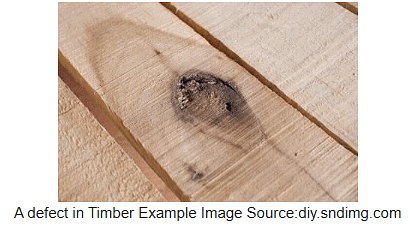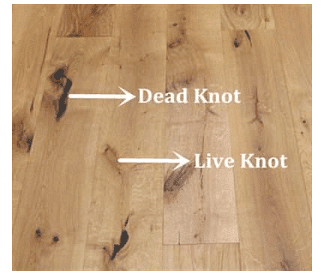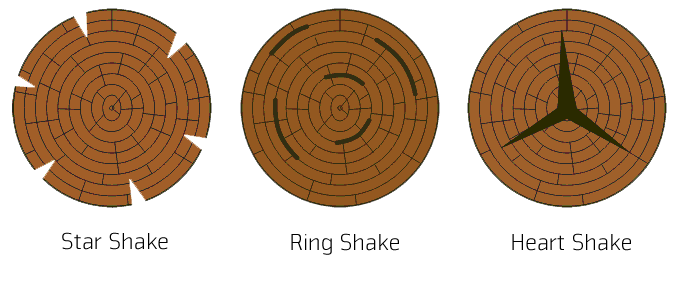Defects in Timber - Defect Types & Causes | Civil Engineering Optional Notes for UPSC PDF Download
Timber is a natural product and every natural product has some imperfections. Timbers are not excluded from that. Most of the defects in timber cause weakness or others sorts of difficulties. However some defects can be beneficial for a specific type of work, for example, twisted wood is good for making a bowl out of timber.

The followings are the five main types of defects in timber:
- Defects due to Natural Forces
- Defects due to Attack by Insects
- Defects due to Fungi
- Defects due to Defective Seasoning
- Defects due to Defective Conversion
Defects in Timber due to Natural Force
1. Knots: Knots are the most common defects caused due to natural forces. During the growth of a tree, branches close to the ground or lower branches die. Bases of those branches remain in the tree as the trees grow. These bases may create imperfection known as knots.Types of Knots: Knots are of two types.
- Dead knots: The remains of damaged branches after drying out they become loose and fall out.
- Live knots: They are sound and firm. If small, are not great of a defect.
Live knots are usually not a problem as they remain firmly attached to the timber. But in dead knots, they are loosely attached and reduce strength. Knots decrease the strength of the wood and thus lower its value for structural uses. Knots cause serious defects when the load is perpendicular to the grains.

2. Twist: Twist in timber rotates the ends of the timber in opposite directions. The main reason behind this defect is twisting of the trees by the strong wind.
 Twisting of the trees by the strong wind
Twisting of the trees by the strong wind
3. Shakes: Shakes are timber defects that occur around the annual ring or growth ring of a timber. In other words, cracks or splits in the woods are called shakes.
It may or may not be a structural problem depending upon depth and use. The main problem is aesthetic. Where the appearance is important, shakes are undesirable.
Types of shakes: Shakes can be classified into three main categories:-
- Star Shakes: This type of shake starts propagating from the bark towards the sapwood and sometimes even towards the heartwood along the lines of medullary rays. Cracks are wider on the outer edge or bark and narrower on the inside (usually sapwood, sometimes heartwood). The main reasons behind star shakes are extreme heat or frosting during the growth of the trees and rapid or uneven seasoning after cutting off the timber. Extreme heat or frost causes temperature difference, which causes shrinkage leading to the crack.
- Cup and/or Ring Shakes: Cup shakes follow the annual growth ring. It is capable to separate the growth ring partially or completely. When the crack separates the annual ring completely, it is called ring shakes. So, all ring shakes are cup shakes, but all cup shakes are not a ring shape. Excessive frost action is the main reason for this type of crack.
- Heart Shakes: Unlike star shakes, heart shakes starts propagating from the pith to the sapwood along the lines of medullary rays. Shrinkage of the interior part of the timber causes this crack.

4. Rind Galls: THe meaning of rind is bark and gall is abnormal growth. So abnormal growth of the bark of the trees is called rind galls. Improper cutting of branches causes this abnormal growth. Wood from this portion of the timber lacks strength and desirable in structure.
5. Upsets: Upsets in various wood indicate that the tree was subjected to crushing or compression. Improper felling of trees, heavy wind blowing during the young age of the tree these are the main reasons behind this type of defect.
Defects of Timber due to Attack by Insects
- Insects like beetles, termites or marine boars eat wood, make holes and weaken the strength of the wood.
- Beetles are small insects that make holes in almost all the sapwoods. The larvae make tunnels through the sapwood in all directions and turn wood into powder.
- Termites live in a colony. They are very fast in eating woods and making tunnels through it. Only a few good kinds of wood can withstand the action of termites.
- Marine boars are found in salt water. Usually, they make tunnels in wood to take refuge or shelter. All kinds of wood or timber are vulnerable to this kind of insect.
Defects in Timber due to Attack by Fungi
- Stain: When fungi feed only on sapwood, where the food materials are stored, it causes a stain. Heartwood doesn’t contain these kinds of food materials and is not affected by it. Stain action causes color but does not affect the strength of the wood.
- Decay: wood eating or wood destroying fungus is responsible for this type of defect in wood. This type of fungi breaks down the cell structure. Both sapwood and heartwood are affected by them. Considerable strength reduction occurs
Defect in Timber due to Defective Seasoning
Faulty method of seasoning causes serious defects in woods. During seasoning of timber, exterior or surface layer of the timber dries before the interior surface. So, stress is developed due to the difference in shrinkage. In a perfect seasoning process, stress is kept minimum by controlling the shrinkage. Some of the defects resulting from defective seasoning are as follows:-
- Bow: Curvature formed in direction of the length of the timber is called bow.
- Cup: Curvature formed in the transverse direction of the timber is called a cup.
- Check: Check is a kind of crack that separates fibers, but it doesn’t extend from one end to another.
- Split: Split is a special type of check that extends from one end to another.
- Honey Combing: Stress is developed in the heartwood during the drying process or seasoning. For these stresses, cracks are created in the form of honeycomb texture.
Defects of Timber due to Defective Conversion
- Boxed Heart: This term is applied to the timber, which is sawn in a way that the pith or the center heart falls entirely within the surface throughout its length.
- Machine Burnt: Overheating is the main reason for this defect.
- Machine Notches: defective holding and pulling causes this defect.
- Miscut: erroneous cutting or sawing of wood causes this defect. Lack of experience in sawing and carelessness is the main reason for erroneous cutting.
- Imperfect Grain: Mismatch in grain alignment.
|
350 videos|464 docs|2 tests
|
FAQs on Defects in Timber - Defect Types & Causes - Civil Engineering Optional Notes for UPSC
| 1. What are some common defects in timber caused by natural forces? |  |
| 2. How do insects contribute to defects in timber? |  |
| 3. How do fungi contribute to defects in timber? |  |
| 4. What are some common defects in timber due to defective seasoning? |  |
| 5. How does defective conversion contribute to defects in timber? |  |
|
350 videos|464 docs|2 tests
|

|
Explore Courses for UPSC exam
|

|
















